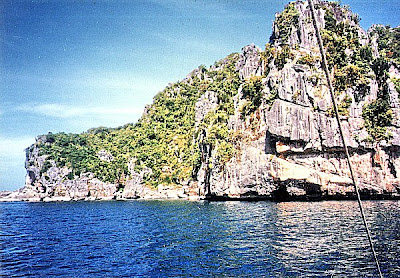 |
| Gigante Norte Island |
After a hearty breakfast with the whole group at the coffee shop, a hectic schedule of island hopping awaited us. We left Balbagon Island, together with other resort guests, by 10 AM. on board a large outrigger boat. Along the way we passed many of the beautiful islands that the Gigantes are known for. After about 30 mins., we reached our first destination: the southern side of Brgy. Gabi in Gigante Norte Island. Our boat docked along a steep rocky wall. As it was high tide, our climbed up the wall was shorter. Upon reaching the top of the wall, we beheld before us a hidden lagoon with clear, shallow waters surrounded by steep and rugged limestone cliffs covered with sparse vegetation.
 |
| A hidden lagoon called Tangke |
Calm, circular and lake-like lagoons (doubtless from the Spanish word laguna meaning “lake”) such as these are found in low latitude countries such as the Philippines. They have openings to the sea, always leeward of prevailing winds, but are protected from it by a sandbar or coral reef. Here, the clear shallow waters rise and fall with the tides. According to one theory, lagoons are formed when hard coral growth in the center fails to keep pace with those on the periphery. Waves and storms disintegrate coral in the center and pile them up at the margin, increasing the height of the island which in the course of time become covered by vegetation.
This salt water lagoon before us was locally called Tangke (“tank”). The lagoon’s rugged limestone periphery, weathered to an incredibly rough surface, are of organic origin. They are formed by the accumulation of the calcareous skeletons of marine animals and plants, mainly coral and coralline algae. Its flora is sparse, mostly a few widely distributed strand plants and trees. Living coral polyps continually extend the fringe. Such was the beauty of the place that we can’t wait to get into our swimming outfits and dip in its shallow, sparklingly clear waters. Simply Heaven! Other members of the party opted to climb its lofty cliffs in an effort to be physically (and dangerously) nearer to their Creator. The place is also a 15-min. boat ride east of Sitio Langub.
 |
| Little Boracay |
After about 30 mins. of lolling around the lagoon, we again boarded our pumpboat for our next destination, a beach called “Little Boracay.” We arrived at 11:10 AM. The beach before us was truly a mini-version of the country’s number one destination, albeit shorter. The other difference is its seclusion. The beach is backed by a steep, densely-vegetated limestone cliff and because of this there are no resorts. The turquoise waters were just as clear and the white sand beach gradually sloping and fine as sugar, with hardly any shells or pebbles. Jandy and Cheska were soon off swimming in the shallow waters as our portable monobloc chairs and tables and beach umbrellas were unloaded. Lunch was served al fresco in food warmers by the beach and eaten kamayan style. And what a lunch it was! Tropical paradise at its best.
 |
| The sandbar of Cabugao Gamay Island |
We would have wanted to stay longer in this beautiful, secluded beach but our itinerary dictated otherwise as we had to leave for our next destination. After packing our stuff, it was off to another boat ride to an inhabited Cabugao Gamay Island which had a very long, treeless sandbar with beige sand. We arrived by 1 PM and were greeted by a native selling to us a sea turtle secured by a rope tied around a notch at the rear of its shell. What a sorry sight. Poor fellow. We refused his offer.
After the usual photo shoot for posterity, it was back to our boat for the return trip. We were back at the resort by 2 PM. Our island hopping tour was the highlight of our trip to Balbagon and the Gigantes Islands. Too bad, all good things must come to pass. The next day, we all left the island early in the morning for the boat trip back to Estancia and the long and tiring land trip to Iloilo City where we had lunch and took the last flight back to Manila, arriving there by 5 PM.



































